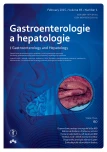Short-term results of the treatment of superficial neoplastic lesions of the stomach using endoscopic submucosal dissection
Authors:
O. Urban 1,2; P. Fojtík 1; Přemysl Falt 1,2
; M. Kliment 1,2; O. Mikolájek 1; M. Mazur 1; A. Foltýs 1; P. Holéczy 1,2; R. Andělová 3; M. Baník 3; I. Kasperčík 3; P. Barabáš 4; J. Richter 4
Authors‘ workplace:
Vzdělávací a výzkumný institut AGEL, o. p. s., pobočka Ostrava-Vítkovice, Vítkovická nemocnice a. s., Centrum péče o zažívací trakt
1; LF OU v Ostravě
2; Patologie, Laboratoře AGEL a. s., Nový Jičín
3; Komplexní onkologické centrum, Nový Jičín
4
Published in:
Gastroent Hepatol 2015; 69(1): 65-69
Category:
Digestive Endoscopy: Original Article
doi:
https://doi.org/10.14735/amgh201565
Overview
The paper presents a prospectively evaluated group of 25 patients treated by gastric endoscopic submucosal dissection (G-ESD). The aim of the study was to evaluate short-term treatment results.
Methods:
All patients treated by G-ESD during the study period 11/2011–10/2014 were included in the study. Lesions were indicated for G-ESD according to expanded criteria. En bloc resection, R0 resection, curative resection and complications were considered as indicators of short-term treatment results.
Results:
A total of 20 (80%) of lesions were neoplastic according to the final histological evaluation. Among them, en bloc, R0 and curative resection could be achieved in 17 (85%), 17 (85%) and 16 (80%) respectively. Perforation was observed in two (8%) of all cases and had to be treated surgically in one (4%) case. The 30-day mortality was 0.
Conclusions:
The paper presents the treatment results of a series of the first group of G-ESD patients from a Czech gastroenterology center. Our results are similar to those reported from Eastern-Asia centers. Nevertheless, the validity of the results is limited by a selection bias.
Key words:
gastric cancer – endsocopic submucosal dissection – R0 resection
The authors declare they have no potential conflicts of interest concerning drugs, products, or services used in the study.
The Editorial Board declares that the manuscript met the ICMJE „uniform requirements“ for biomedical papers.
Submitted:
24. 12. 2014
Accepted:
27. 1. 2015
Sources
1. Jemal A, Bray F, Center MM et al. Global cancer statistics. CA Cancer J Clin 2011; 61(2): 69 – 90. doi: 10.3322/ caac.20107.
2. Česká onkologická společnost ČLS JEP. [online]. Dostupné z: http:/ / www.linkos.cz/ .
3. Kodera Y, Sasako M, Yamamoto S et al. Identification of risk facors for the development of complications following extended and superextended lymphadenectomies for gastric cancer. Br J Surg 2005; 92(9): 1103 – 1109.
4. Chiu PW, Teoh HY, To KF et al. Endoscopic submucosal dissection (ESD) compared with gastrectomy for treatment of early gastric neoplasia: a retrospective cohort study. Surg Endosc 2012; 26(12): 3584 – 3591. doi: 10.1007/ s00464 ‑ 012 ‑ 2371 ‑ 8.
5. Gotoda T, Yanagisawa A, Sasako M et al.Incidence of lymph node metastasis from early gastric cancer: estimation with a large number of cases at two large centers. Gastric Cancer 2000; 3(4): 219 – 225.
6. Japanese Gastric Cancer Association. Japanese gastric cancer treatment guidelines 2010 (ver. 3). Gastric Cancer 2011; 14(2): 113 – 123. doi: 10.1007/ s10120 ‑ 011 ‑ 0042 ‑ 4.
7. Ono H, Kondo H, Gotoda T et al. Endoscopic mucosal resection for treatment of early gastric cancer. Gut 2001; 48(2): 225 – 229.
8. Ohkuwa M, Hosokawa K, Boku N et al. New endoscopic treatment for intramucosal gastric tumors using an insulated ‑ tip diathermic knife. Endoscopy 2001; 33(3): 221 – 226.
9. Ganjoho.jp [online in Japanese]. Available from: http:/ / ganjoho.jp/ public/ statistics/ pub/ statistics01.html.
10. Urban O, Vítek P, Fojtík P et al. Endoscopic submucosal dissection. Initial experience in the Czech Republic. Folia Gastroenterol Hepatol 2006; 4(1): 4 – 10.
11. Jung H, Bae JM,Choi MG et al. Surgical outcome after incomplete endoscopic submucosal dissection of gastric cancer. Br J Surg 2011; 98(1): 73 – 78. doi: 10.1002/ bjs.7274.
12. Lian J, Chen S, Zhang Y et al. A meta‑analysis of endoscopic submucosal dissection and EMR for early gastric cancer. Gastrointest Endosc 2012; 76(4): 763 – 770. doi: 10.1016/ j.gie.2012.06.014.
13. Park YM, Cho E, Kang HY et al. The effectiveness and safety of endoscopic submucosal dissection compared with endoscopic mucosal resection for early gastric cancer: a systematic review and metaanalysis. Surg Endosc 2011; 25(8): 2666 – 2677. doi: 10.1007/ s00464 ‑ 011 ‑ 1627 ‑ z.
14. Pimentel ‑ Nunes P, Mourao F, Veloso N et al. Long‑term follow‑up after endoscopic resection of gastric superficial neoplastic lesions in Portugal. Endoscopy 2014; 46(11): 933 – 940. doi: 10.1055/ s ‑ 0034 ‑ 1377348.
15. Toyokawa T, Inaba T, Omote S et al. Risk factors for perforation and delayed bleeding associated with endoscopic submucosal dissection for early gastric neoplasms: analysis of 1123 lesions. J Gastroenterol Hepatol 2012; 27(5): 907 – 912. doi: 10.1111/ j.1440 ‑ 1746.2011.07039.x.
Labels
Paediatric gastroenterology Gastroenterology and hepatology SurgeryArticle was published in
Gastroenterology and Hepatology

2015 Issue 1
- Spasmolytic Effect of Metamizole
- Metamizole vs. Tramadol in Postoperative Analgesia
- Metamizole at a Glance and in Practice – Effective Non-Opioid Analgesic for All Ages
- Safety and Tolerance of Metamizole in Postoperative Analgesia in Children
- Metamizole in perioperative treatment in children under 14 years – results of a questionnaire survey from practice
Most read in this issue
- A practical contribution to the diagnostics and treatment of focal nodular hyperplasia and adenomas in the liver from the perspective of a hepatologist, radiologist, pathologist and surgeon
- Small intestinal bacterial overgrowth syndrome
- Topical treatment of inflammatory bowel diseases
- The importance of fecal calprotectin in the diagnostics and treatment of inflammatory bowel diseases
